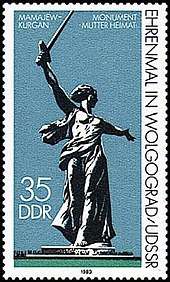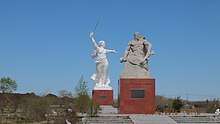The Motherland Calls
The Motherland Calls (Russian: Родина-мать зовёт!, tr. Rodina-mat' zovyot!, lit. 'Homeland-Mother Is Calling!') is the compositional centre of the monument-ensemble "Heroes of the Battle of Stalingrad" on Mamayev Kurgan in Volgograd, Russia. It was designed by sculptor Yevgeny Vuchetich and structural engineer Nikolai Nikitin, and declared the tallest statue in the world in 1967. At 85 m (279 ft), it is the tallest statue in Europe and the tallest statue (excluding pedestals) of a woman in the world.[1]
| The Motherland Calls | |
|---|---|
| Russia | |
| For the heroes of the Battle of Stalingrad | |
| Unveiled | 15 October 1967 |
| Location | 48°44′33″N 44°32′13″E near |
| Designed by | Yevgeny Vuchetich, Nikolai Nikitin |
Construction
The work of sculptor Yevgeny Vuchetich and engineer Nikolai Nikitin is an 85-metre (279 ft) figure of a woman stepping forward with a raised sword. The statue is an allegorical image of the Motherland, which calls on its sons and daughters to repulse the enemy and return to the attack.
The Motherland Calls is highly complex from an engineering point of view, due to its characteristic posture with a sword raised high in the right hand and the left hand extended in a calling gesture. The technology behind the hollow statue is based on a combination of prestressed concrete with wire ropes, a solution which can also be found in another work of Nikitin's, the Ostankino Tower in Moscow. The sculpture is hollow. Inside, the entire statue consists of separate cells or chambers, like rooms in a building. The concrete walls of the sculpture are 25–30 cm (9.8–11.8 in) thick.[2]
The construction of the monument was started in May 1959 and completed on 15 October 1967.[3] It was the tallest sculpture in the world at the time of creation. Restoration work on the main monument of the monument complex was done in 1972, when the sword was replaced by another entirely consisting of stainless steel.[2]
It is most likely that Vuchetich sculpted the figure from the discus thrower Nina Dumbadze, and the face from his wife Vera.[4] According to various sources, Valentina Izotova[5] or Ekaterina Grebneva[6] posed for the sculpture. It is also believed that the statue has parallels with the figure of the "Marseillaise" on the Arc de Triomphe in Paris, and that the statue's pose was inspired by the statue of Nike of Samothrace.
At night, the sculpture is illuminated by floodlights. It was specially illuminated as part of a light show titled "The Light of the Great Victory", marking the 72nd anniversary of the victory over Nazi Germany.[7]
Measurements
When the memorial was dedicated in 1967 it was the tallest statue in the world, measuring 85 m (279 ft) from the tip of its sword to the top of the plinth.[8] The plinth measures another 2 m (6.6 ft), and is installed on a concrete foundation with a depth of 16 m (52 ft). The figure measures 52 m (171 ft), and the sword 33 m (108 ft).[9] The monument weighs over 8,000 tonnes (8,800 short tons). The statue contains 5,500 tonnes (6,100 short tons) tonnes of concrete and 2,400 tonnes (2,600 short tons) tons of metal structures, the sword itself weighs 14 tonnes (15 short tons).[10] The rigidity of the frame is supported by 99 metal cables constantly in tension.
Dedication

Two hundred steps, symbolizing the 200 days of the Battle of Stalingrad, lead from the bottom of the hill to the monument.[1] The statue appears on both the current flag and coat of arms of Volgograd Oblast.
Marshal of the Soviet Union Vasily Ivanovich Chuikov is buried in the area of the monument, as is famous Soviet sniper Vasily Zaytsev, who killed 225 soldiers and officers of the German army and their allies in the battle of Stalingrad.
The monument is the central part of the triptych, consisting of the monuments "Rear-Front" in Magnitogorsk and "Warrior-Liberator" in Berlin's Treptower Park. It is understood that the sword, forged by the side of the Urals, was later raised by Motherland in Stalingrad and dropped after the Victory in Berlin.[11][12][13][14]
Structural problems
The sword was originally made of stainless steel, trimmed with titanium sheets. The huge mass and high windage of the sword, due to its colossal dimensions, caused a strong swinging of the sword under the influence of wind loads, which caused excessive mechanical stress in the place where the hand holding the sword was attached to the body of the sculpture. Deformations in the design of the sword also caused the movement of sheets of titanium plating, creating pitched sound of thundering metal. Therefore, in 1972, the blade was replaced by another – entirely consisting of stainless steel – and in the upper part of the sword, holes were provided that made it possible to reduce its windage.[15][16]
In 2009, reports said the statue was leaning due to changes in groundwater level causing movement of the foundations. The statue is not fixed to its foundations and is held in place only by its weight. An anonymous official claimed that it had shifted 20 cm (7.9 in) and was not expected to move much farther without collapsing.[17] A program of monument restoration was developed in 2008–2009, and conservation and restoration work started in 2010.[18]
In spring 2017, a comprehensive restoration program of the monument at a cost of two billion rubles ($35,000,000) began. The ropes inside the statue were replaced to ensure its stability, the interior and all formed cracks were repaired and more than 6,000 m2 (65,000 sq ft) of concrete surfaces were restored.[19] The restoration of the statue was completed by April 2020.[20]
Facts

- The sculpture is depicted on the postage stamp of the GDR 1983.
- A copy of the sculpture is present in Manzhouli, China.
- The sculpture is also depicted on a 1975 one Ruble commemorative coin.
See also
- Socialist realism
- Mother Motherland, name for any of several huge statues in various cities of the former Soviet Union
- Worker and Kolkhoz Woman
- List of statues by height
Notes
- "Sobering memorials and Europe's tallest statue: What England fans can expect in Volgograd". The Telegraph.
- "The Motherland Calls - Volgograd, Russia - Leading Landmarks". Tutorial At Home. 27 July 2018.
- "Mamayev Kurgan Memorial Complex "To the Heroes of the Battle of Stalingrad" - UNESCO World Heritage Centre". UNESCO World Heritage.
- "«Родина-мать зовет!» 10 фактов о монументе". culture.ru (in Russian). Retrieved 2017-02-27.
- "Родину-мать зовут Валей". // Волгоград-Инфо. 15 June 2003. Archived from the original on 2011-08-26. Retrieved 2010-10-17.
- Галкина, Анна. "Родина-мать обосновалась на Семи Ветрах". // Ваша газета. 8 June 2011. Archived from the original on 2012-02-04. Retrieved 2011-11-15.
- "8th May, 2017. A view of the Motherland Calls monument illuminated as part of a light show titled "The Light of the Great Victory" and marking the 72nd". Alamy.com. Retrieved 2 November 2018.
- Pearman, Hugh (5 November 2014). "The Power of Remembrance". RIBA Journal.
- "Памятник-ансамбль героям Сталинградской битвы на Мамаевом кургане". Подвиг народа: Памятники Великой Отечественной войны. 1980. p. 127.
- "Родина-мать зовет! – Военная история – Каталог статей – Танковое братство". Танковое братство.
- Ильин С. Б., Лонгинов А. С., Сульдин А. В. (1986). Всенародная академия. М.: Политиздат. p. 62.CS1 maint: multiple names: authors list (link)
- Кудзоев О. А., Ваганов А. С. (1989). Скульптурная летопись края. Челябинск: Южно-Уральское книжное издательство. p. 101. ISBN 5-7688-0158-8.CS1 maint: multiple names: authors list (link)
- Слука И. (2015). "Великая Отечественная война". 100 самых знаменитых монет СССР. p. 17.
- Монумент скульптура «Родина-мать» в Волгограде
- "Как устроен мемориал «Родина-мать»". BIGPICTURE.RU. Retrieved 2016-06-03.
- "Скульптура «Родина-мать зовет!» в Волгограде на фото и карте". russights.ru. Retrieved 2016-06-03.
- Galpin, Richard (8 May 2009). "Russia's massive leaning statue". BBC News. Retrieved 2016-02-11.
- "Родина-Мать ушла на «больничный" [Motherland" goes on "sick leave"] (in Russian). V1.ru. 15 October 2010. Retrieved 2016-02-11.
- "Родину-мать на Мамаевом кургане оденут на полтора года в строительные леса". V1.ru. 19 January 2017.
- "Открытие монумента "Родина-мать зовет!" после реставрации отложено из-за коронавируса". Interfax.ru. Retrieved 29 April 2020.
| Wikimedia Commons has media related to The Motherland Calls. |
Further reading
.svg.png)
1. Statue of Unity 240 m (790 ft) (incl. 58 m (190 ft) base)
2. Spring Temple Buddha 153 m (502 ft) (incl. 25 m (82 ft) pedestal and 20 m (66 ft) throne)
3. Statue of Liberty 93 m (305 ft) (incl. 47 m (154 ft) pedestal)
4. The Motherland Calls 87 m (285 ft) (incl. 2 m (6 ft 7 in) pedestal)
5. Christ the Redeemer 38 m (125 ft) (incl. 8 m (26 ft) pedestal)
6. Michelangelo's David 5.17 m (17.0 ft) (excl. 2.5 m (8 ft 2 in) plinth)
- Scott W. Palmer, "How Memory was Made: The Construction of the Memorial to the Heroes of the Battle of Stalingrad", The Russian Review 68:3 (July 2009), 373–407.
External links
- Google Maps Satellite view of statue in Volgograd
- The Motherland Calls: Russia's symbol of victory (23 minute RT documentary)
- YouTube video of Родина-мать зовёт! ("Rodina Mat' Zovyot!")
- View from the top and inside
| Records | ||
|---|---|---|
| Preceded by Tokyo Wan Kannon 56 m (183.7 ft) |
World's tallest statue 1967–1989 |
Succeeded by Dai Kannon of Kita no Miyako park 88 m (289 ft) |